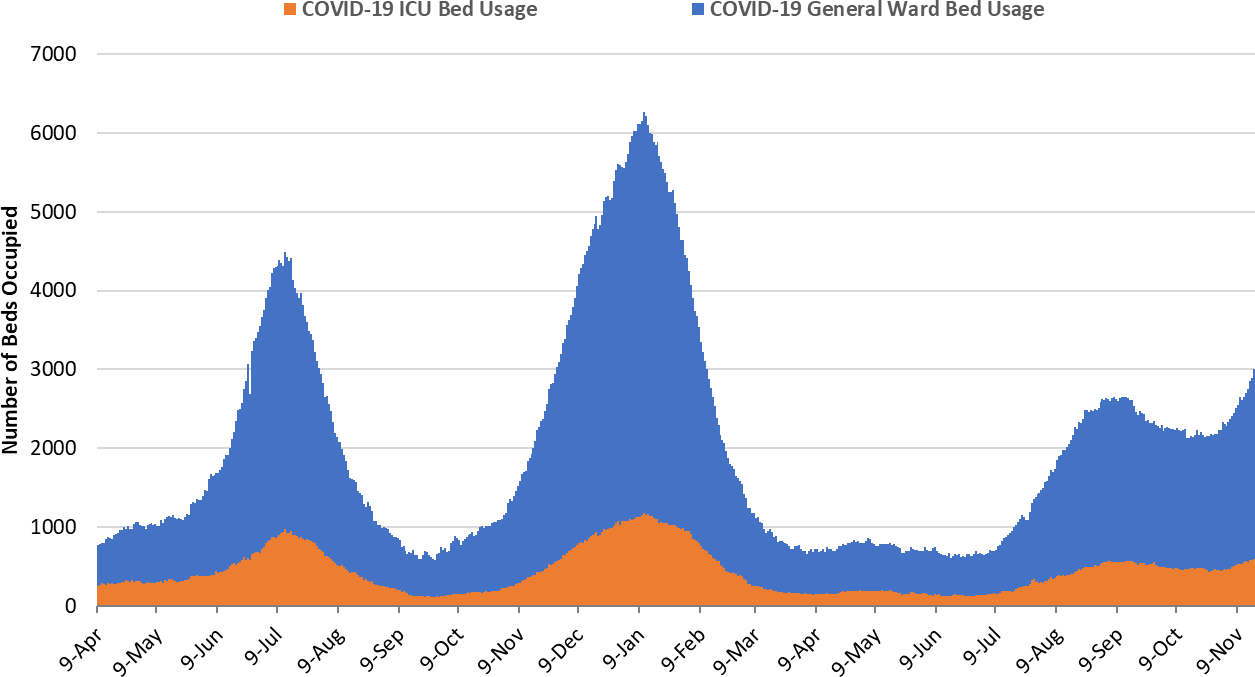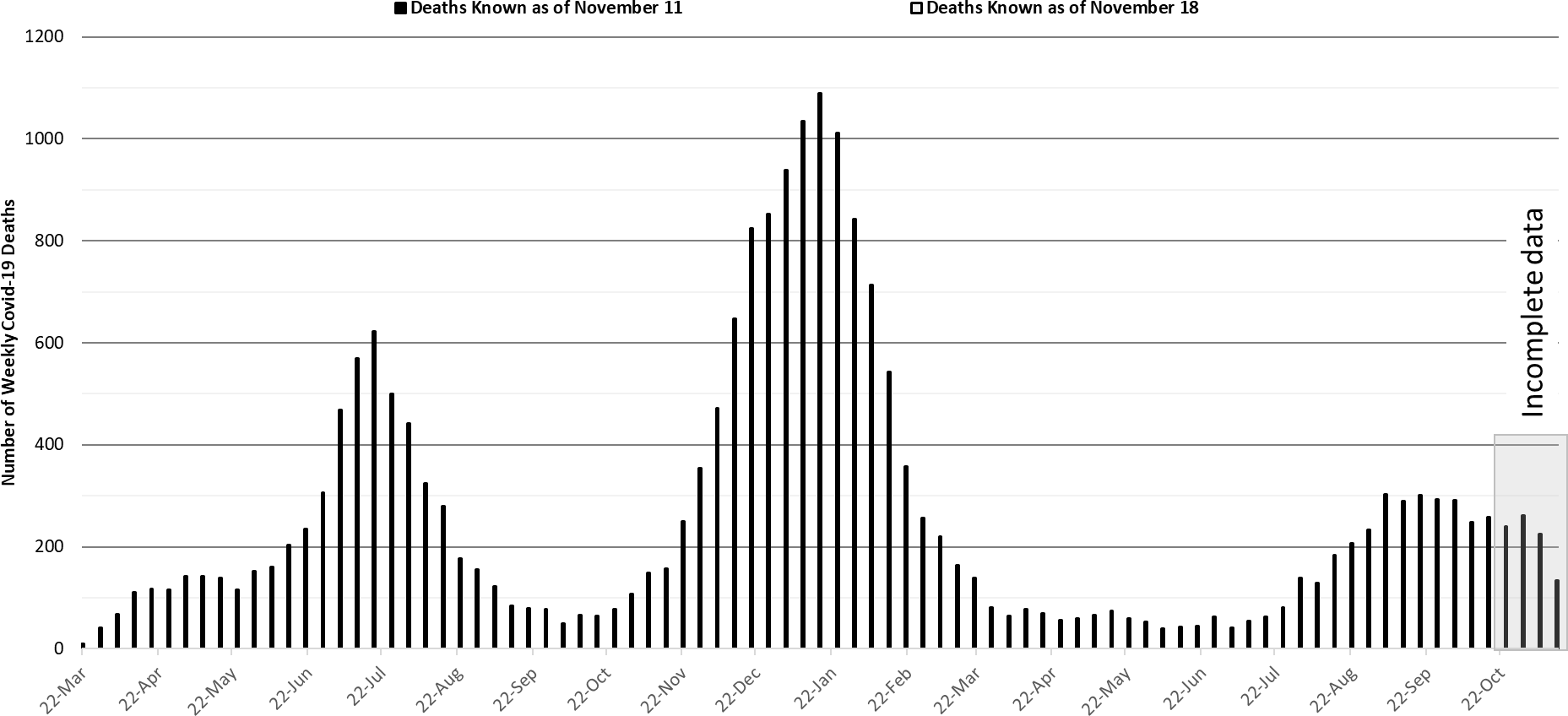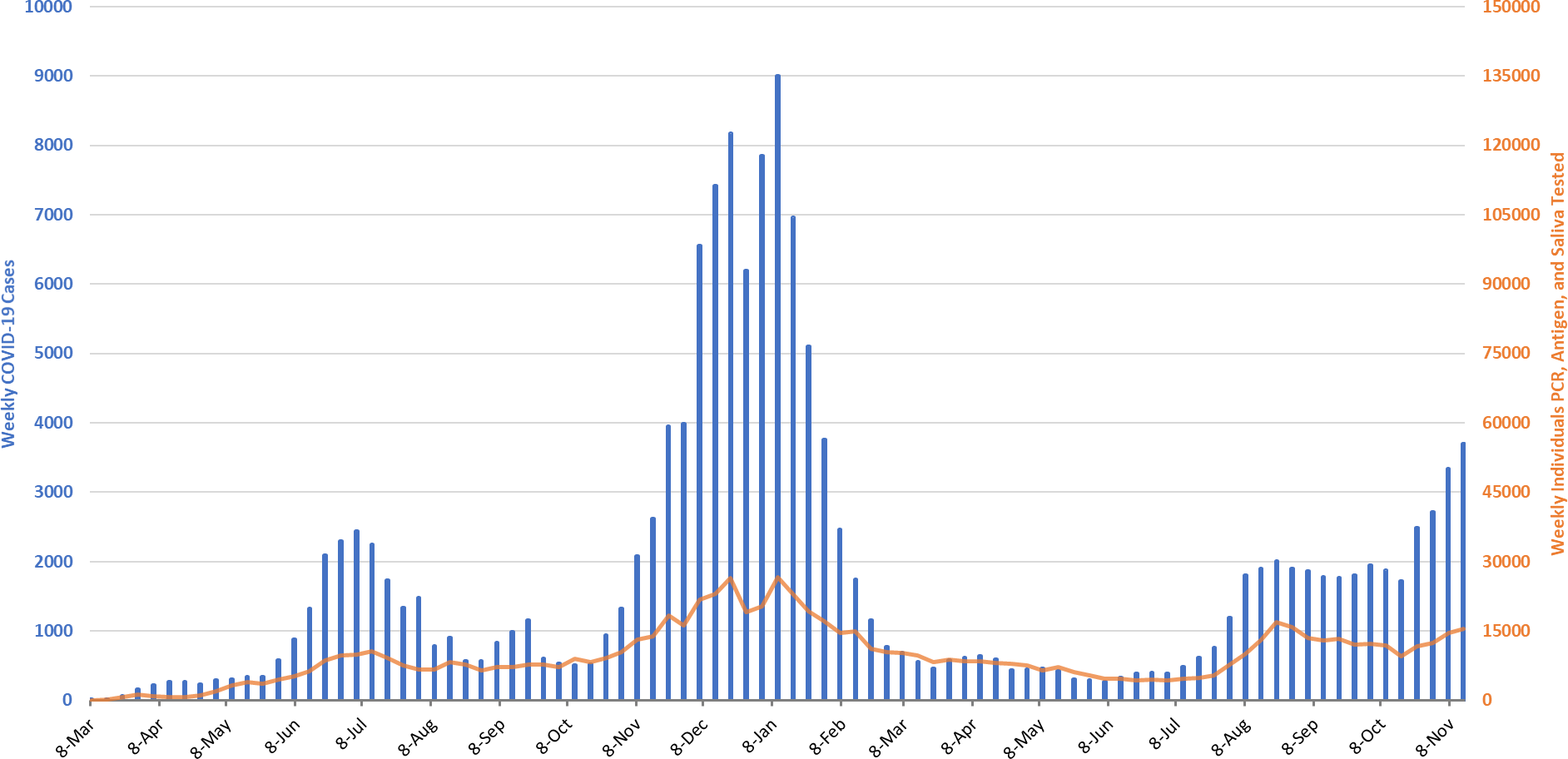Weekly Arizona COVID-19 Data Report – November 19
Note this forecast page is not the most recent forecast available.
View the most current forecast report
Researcher Analyzes Arizona COVID-19 Spread Models for Decision-Makers
The following information regarding the spread of COVID-19 in Arizona was prepared by Joe Gerald, MD, PhD, a researcher at the Mel and Enid Zuckerman College of Public Health (MEZCOPH) at the University of Arizona. This information has also been reviewed by other MEZCOPH faculty.
This data were obtained from the Arizona Department of Health Services COVID-19 webpage and reflect conditions in Arizona as of November 19, 2021.
This information is intended to help guide our response to the outbreak. It is not intended to predict how this pandemic will evolve. Rather, this model extrapolates what might occur if current conditions remain unchanged. As regional authorities and healthcare providers respond, their actions are expected to mitigate the worst consequences of this pandemic.

COVID-19 Disease Outbreak Forecast
Arizona State and Pima County
Updated November 19, 2021
Disclaimer: This information represents my personal views and not those of The University of Arizona, the Zuckerman College of Public Health, or any other government entity. Any opinions, forecasts, or recommendations should be considered in conjunction with other corroborating and conflicting data. Updates can be accessed at https://publichealth.arizona.edu/news/2021/covid-19-forecast-model.
For the week ending November 14th, 25234 Arizonans were diagnosed with COVID-19, a 6% increase from last week’s initial tally of 23864 cases (Figure 1). Cases are currently being diagnosed at a rate of 347 cases per 100K residents per week; this rate is increasing by 13 cases per 100K residents per week. Rates are highest among those 15 – 24 years and are the lowest among those 65+ years, 402 versus 240 cases per 100K residents per week, respectively (Figure 2a below).

|
Figure 1. Weekly COVID-19 Cases in Arizona and Number of Individuals Undergoing COVID-19 Diagnostic Testing March 1, 2020 – November 14, 2021. |
Arizona continues to experience a high number of cases, hospitalizations, and deaths. With waning vaccine efficacy and a potentially short duration of acquired immunity, herd immunity is not achievable. As winter approaches, more previously vaccinated and previously infected individuals will become susceptible. While these individuals will remain mostly protected from severe outcomes, they will contribute to community transmission. Unvaccinated Arizonans will not be able to avoid infection by “free riding” on high levels of community immunity. The decision to remain unvaccinated carries a much greater risk than getting vaccinated does.
Arizona’s new case ranking has fallen 7 spots to 15th. The nation’s leaders have again rearranged themselves: Michigan (697), New Mexico (551), New Hampshire (541), Minnesota (519), and North Dakota (446). Given the experience of other states, Arizona’s delta wave is unlikely reach last winter’s peak of 916 cases per 100K residents, but it will certainly last longer making it devastating in its own way.
According to the CDC, only 17% of Arizona adults are fully vaccinated with a third dose booster (37th overall); twice as many of those 65+ years are (35%, 40th overall). Vermont is winning the booster race at 31% and 58%, respectively. As winter approaches, waning immunity among those without a booster will place them at risk. The CDC guidance on boosters has widened eligibility to all adults. The ADHS Vaccine Dashboard shows weekly doses delivered rose meaningfully to 170K doses last week.
Figure 2a shows moderating transmission among all age groups except those ≥65 years of age. A similar pattern of moderating transmission is evident among children except those 5 years of age (Figure 2b). Ultimately our poor performance is attributable to the state’s low vaccination rates, ineffectual or absent mitigation efforts, and waning immunity from prior infection or the 2-dose vaccination sequence.
The past two days have seen 5000+ cases reported to the ADHS COVID-19 Dashboard. This update includes 1 of 2 of those days. At least some of these cases are backfilling earlier data rather than capturing newly emergent cases. It will take another week to ascertain what implications, if any, these 2 days have for transmission as a whole.

|
Figure 2a. COVID-19 Cases in Arizona by Age Group March 7 – November 14, 2021. |

|
Figure 2b. COVID-19 Cases in Arizona among Children by Age Group March 7 – November 14, 2021. |
Test positivity, at 29%, continues to rise (Figure 3). Testing is inadequate for public health practice and many cases are going undiagnosed.

|
Figure 3. Weekly Number of Patients Undergoing Traditional Nasopharyngeal PCR Testing and Associated Percent Positivity March 1, 2020 – November 14, 2021. |
As of November 17th, 2403 (27%) of Arizona’s 8774 general ward beds were occupied by COVID-19 patients, a 14% increase from last week’s 2113 occupied beds (Figure 4 and Figure 5 Panel A). Another 484 (6%) beds remained available for use. The number of available ward beds is the lowest of the pandemic. Five-hundred ninety-seven (597, 34%) of Arizona’s 1782 ICU beds were occupied by COVID-19 patients, a 12% increase from last week’s 535 occupied beds (Figure 4 and Figure 5 Panel B). An additional 112 (6%) ICU beds remained available for use, much lower than last week’s 147 beds.

|
Figure 4. Arizona Daily COVID-19 General Ward and ICU Census April 9, 2020 – November 17, 2021. |
While peak occupancy is unlikely to reach prior peaks, the base of the wave is going to be much broader. So far, the delta wave has seen 97 days with a combined occupancy >2000 patients. For reference, the summer 2020 and winter 2021 waves saw 57 and 98 days, respectively.

|
Figure 5. COVID-19 Occupancy as a Percent of Listed General Ward (A, left) and ICU (B, right) Capacity in Arizona April 20, 2020 – November 17, 2021. |
Overall hospital occupancy remains far above seasonal levels. Safety margins, as measured by excess available beds, remain near historical lows (Figure 6). In fact, the number of available ward beds fell below 500 beds for the first time. Hospitals should be prepared for >20% ward occupancy and >25% ICU occupancy for some time to come. One previously unencountered problem seems to be discharging patients who are stable but still too ill to return home. Normally, these patients would be discharged to long-term acute care hospitals (LTACHs) for a period of recuperation. It appears that this typical outlet may be near capacity creating a new bottleneck in the critical care system.

|
Figure 6. Observed Excess Non-Surge General Ward and ICU Capacity in Arizona March 26, 2020 – Nov 17, 2021. |
Arizona has been experiencing >200 COVID-19 deaths per week since August 22nd. The week ending September 5th has now recorded 302 deaths (Figure 7). The weeks ending September 12th and 19th are close behind with 290 and 301 deaths, respectively. So far, 21886 Arizonans have lost their lives to COVID-19 making it Arizona’s leading cause of death, the only state to achieve such a distinction.

|
Figure 7. Weekly Arizona COVID-19 Deaths March 16, 2020 – November 14, 2021. |
Pima County Outlook
For the week ending November 14th, 3697 Pima County residents were diagnosed with COVID-19 a 13% increase from last week’s tally (Figure 8).

|
Figure 8. Weekly COVID-19 Cases in Pima County and Number of Individuals Undergoing COVID-19 Diagnostic Testing March 1, 2020 – November 14, 2021. |
New cases are being diagnosed at a rate of 353 cases per 100K residents per week and this rate is increasing by 35 cases per 100K residents per week. Trends across the various age groups appear in Figure 9.

|
Figure 9. COVID-19 Cases in Pima County by Age Group March 7, 2020 – November 14, 2021. |
Summary
- Arizona continues to experience high levels of community transmission. Test positivity also remains high reminding us that test capacity, accessibility, and/or uptake is inadequate. Increasing case rates among older, highly vaccinated groups serves as a warning that major behavioral shifts and/or waning immunity could result in future increases in not only cases but also hospitalizations. In general, transmission will likely increase in fits-and-starts through the holidays before gradually subsiding in early 2022. While Arizona is unlikely to set new records for daily cases, the base of the delta wave will be considerably broader than any other creating substantial misery in its own way.
- As of November 14th, new cases were being diagnosed at a rate of 347 cases per 100K residents per week. The rate was increasing by 13 cases per 100K residents per week. Three counties (Navajo, Greenlee, and Gila) have case rates nearing their previous pandemic highs (see Appendix). Although we are not near previous highs, we are struggling a bit to get control of transmission here in Pima County.
- Waning vaccine efficacy and a short duration of acquired immunity means the unvaccinated cannot “free ride” on high levels of community immunity. At this time vaccine mandates for all adults are warranted for their protection as well as the community’s. Persistently high levels of community transmission, and more importantly hospitalizations, are possible for an extended time until the supply of unvaccinated, previously uninfected adults is exhausted. https://www.science.org/doi/10.1126/science.abm0620
- Waning vaccine immunity also makes it imperative that all adults who were previously vaccinated obtain a third shot booster, particularly those 50+ years of age. While vaccination provides greater durability of protection for severe illness than mild reinfection, a third dose booster provides important incremental benefits to individuals, families, and communities. https://jamanetwork.com/journals/jama/fullarticle/2786040
- Risk factors for breakthrough hospitalization and death were recently elucidated in the British Medical Journal: Down’s syndrome, kidney transplantation, sickle cell disease, nursing home residents, chemotherapy, recent bone marrow or solid organ transplantation (ever), HIV/AIDS, dementia, Parkinson’s disease, neurological conditions, and liver cirrhosis. https://www.bmj.com/content/374/bmj.n2244
- Vaccination remains the most important public health priority to reduce transmission and severe illness; however, mask mandates, restrictions on indoor gatherings, and targeted business mitigations are needed to reduce/control transmission in the short-run with the primary goal being to avoid overwhelming our critical care facilities.
- The FDA/CDC now recommends booster shots for all adults. https://www.cdc.gov/coronavirus/2019-ncov/vaccines/booster-shot.html
- For those residing in unvaccinated households, considerable benefit accrues if any one member becomes vaccinated. So, there is something you can do to protect loved ones even if others remain hesitant. https://jamanetwork.com/journals/jamainternalmedicine/fullarticle/2785141
- An analysis from the Texas Department of State Health Services reaffirms the unvaccinated are driving cases and hospitalizations https://www.dshs.texas.gov/immunize/covid19/data/cases- and-deaths-by-vaccination-status-11082021.pdf.
- See also San Diego County Health Department Weekly Surveillance Report which documents this phenomenon in real-time (download the COVID-19 Watch pdf-scroll down to find). https://www.sandiegocounty.gov/content/sdc/hhsa/programs/phs/community_epidemiology/dc/2019-nCoV/status.html
- Yet another systematic review and meta-analysis shows that masking (50% reduction), hand washing (50% reduction) and physical distancing (25% reduction) work to reduce viral transmission. https://www.bmj.com/content/375/bmj-2021-068302
- COVID-19 hospital occupancy is holding steady and will likely exceed 25% of all beds in the general ward and 30% of beds in the ICU for the remainder of the year. Access to care will continue to be restricted in the face of staff shortages in inpatient and outpatient settings.
- A disappointing analysis indicating that only 70% of healthcare personnel at hospitals are fully vaccinated. https://www.ajicjournal.org/article/S0196-6553(21)00673-8/fulltext
- Weekly COVID-19 deaths continue to exceed 200 per week and will once again reach, and likely exceed, 300 per week soon. So far, 21886 Arizonans have lost their lives to COVID-19.
- Check out the AzPHA’s COVID-19 Mortality in Arizona report showing that COVID-19 was the leading cause of death in Arizona. https://azpha.org/2021/10/20/new-azpha-report-covid-19-has-been-the-leading-cause-of-death-during-the-pandemic-in-arizona/
- An updated AzPHA analysis shows Arizona was the only state where this happened. This isn’t like the movies where an undisciplined team of misfits (Arizonans) with a poor coaching staff (governor and legislature) will win the championship. In the real world, your team loses, often by a lot! https://secureservercdn.net/166.62.110.60/p7p.8e2.myftpupload.com/wp-content/uploads/2021/11/AzPHA-Data-Brief-COVID-vs-Heart-Disease-and-Cancer-50-States-nov-3.pdf
- Adding insult to injury, a recent study of COVID-19’s impact on life expectancy demonstrated that the only country to see a greater reduction in life expectancy than the US was Russia. Combining the AzPHA analysis with this new data arguably leads to the conclusion that Arizona’s pandemic performance was the worst of the worst! https://www.bmj.com/content/375/bmj-2021-066768
- South Korea, Taiwan, and New Zealand all saw life expectancy increases despite COVID-19 owing to their strong pandemic response (and essentially island hideaways).
- In another fascinating MMWR study, non-COVID mortality among the unvaccinated was more than twice that of the vaccinated. Will be interesting to see this finding explored further, but in the short-term, just one more reason not to defer to the unvaccinated’s views on health and health policy!! https://www.cdc.gov/mmwr/volumes/70/wr/mm7043e2.htm
- Lastly, in a similar vein, the Lancet recently published an analysis of the HPV vaccine’s impact on cervical cancer in the UK. The short-story… “The HPV immunization programme has successfully almost eliminated cervical cancer in women born since September 1, 1995.” It is success stories like these that make it difficult to accept anti-vaccine sentiments and misinformation. https://www.thelancet.com/journals/lancet/article/PIIS0140-6736(21)02178- 4/fulltext
Forecast reports to date, available as PDFs
Download PDF to view additional charts of Arizona counties, available in appendix of report.
2020 Reports
Based on what we know now about this pandemic, we support guidelines for social distancing to slow the spread of the virus and urge everyone to follow the recommendations provided by the Centers for Disease Control and Prevention (CDC) to protect yourself, your family, your neighbors, and your employees. Please heed the recommendations as provided by the CDC.
COVID covid coronavirus virus covid19 corona forecast model

